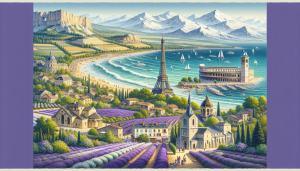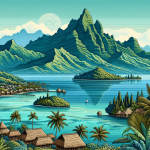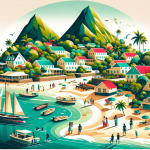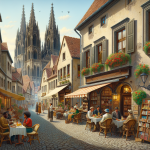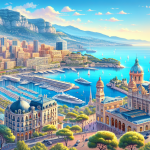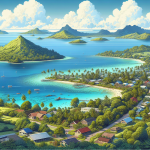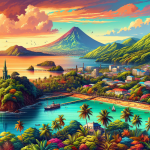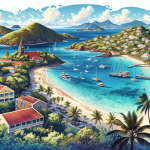Exploring the Allure of France: A Comprehensive Travel Guide
When you think of **France**, a myriad of images flood the mind: the romantic streets of Paris, the lavender fields of Provence, the sun-kissed beaches of the French Riviera, and the historic châteaux of the Loire Valley. This enchanting country has long been a favorite destination for travelers from around the globe, and for good reason. France offers a diverse range of experiences, catering to history buffs, food enthusiasts, art lovers, and adventure seekers alike. In this comprehensive travel guide, we will delve into the various facets of France, exploring its famous landmarks, hidden gems, cultural experiences, and culinary delights. From the bustling streets of Paris to the serene countryside, France promises a journey of unforgettable memories. Whether you are planning your first trip or returning to this captivating country, our guide will help you uncover the best that France has to offer, ensuring a fulfilling and enriching travel experience.
Paris: The Heartbeat of France
Iconic Landmarks
No visit to France is complete without spending time in its capital, **Paris**. The city is synonymous with iconic landmarks such as the **Eiffel Tower**, **Louvre Museum**, and **Notre-Dame Cathedral**. The **Eiffel Tower**, an architectural marvel, offers breathtaking views of the city from its observation decks. The **Louvre Museum**, home to the world-famous **Mona Lisa**, is a treasure trove of art and history. Meanwhile, the **Notre-Dame Cathedral**, with its Gothic architecture, stands as a testament to centuries-old craftsmanship.
Charming Neighborhoods
Paris is also known for its charming neighborhoods, each with its unique character. The **Montmartre** district, with its bohemian vibe, is perfect for leisurely strolls and artistic inspiration. The **Marais** offers a blend of historical and contemporary elements, with narrow streets, chic boutiques, and vibrant nightlife. The **Latin Quarter**, home to the Sorbonne University, is bustling with students and intellectuals, adding to its lively atmosphere.
Culinary Delights
Parisian cuisine is another highlight that should not be missed. From freshly baked croissants and baguettes to exquisite dishes at Michelin-starred restaurants, the city offers a culinary journey like no other. Don’t forget to visit the local markets, such as **Marché d’Aligre** and **Rue Montorgueil**, to sample fresh produce, cheeses, and charcuterie.
The French Riviera: Sun, Sea, and Glamour
Beaches and Coastal Towns
The **French Riviera**, or **Côte d’Azur**, is renowned for its sun-drenched beaches, luxurious resorts, and glamorous lifestyle. Towns like **Nice**, **Cannes**, and **Saint-Tropez** attract celebrities and travelers alike with their stunning coastlines and vibrant nightlife. **Nice** is famous for its promenades and pebble beaches, while **Cannes** hosts the prestigious film festival each year. **Saint-Tropez** is the epitome of luxury, with its upscale boutiques, yachts, and beach clubs.
Inland Adventures
While the coastal towns are the main attractions, the inland areas of the French Riviera offer their own charm. The **Provence-Alpes-Côte d’Azur** region boasts rolling hills, vineyards, and picturesque villages like **Eze** and **Grasse**. Eze, perched on a hilltop, provides panoramic views of the Mediterranean Sea, while Grasse is famous for its perfume industry, allowing visitors to tour perfume factories and create their own fragrances.
Provence: A Tapestry of Colors and Scents
Lavender Fields and Vineyards
**Provence** is a region that captivates with its natural beauty and sensory experiences. The lavender fields, particularly in the **Plateau de Valensole** and **Luberon** area, create a sea of purple flowers, especially during the blooming season in July. Vineyards are another hallmark of Provence, with the **Côtes de Provence** wine region producing some of the finest rosé wines in the world. A visit to a vineyard offers a chance to taste local wines and learn about the winemaking process.
Historic Villages and Markets
The region is dotted with historic villages, each offering a glimpse into the past. **Gordes**, with its stone houses and narrow streets, is often referred to as one of the most beautiful villages in France. **Roussillon**, known for its ochre cliffs, provides a striking contrast of colors against the azure sky. Local markets, such as those in **Aix-en-Provence** and **Arles**, offer an array of fresh produce, artisanal goods, and regional specialties, allowing visitors to immerse themselves in the local culture.
The Loire Valley: A Journey Through History
Majestic Châteaux
The **Loire Valley**, often called the “Garden of France,” is renowned for its majestic châteaux. These grand castles, such as **Château de Chambord**, **Château de Chenonceau**, and **Château de Villandry**, showcase Renaissance architecture and beautifully landscaped gardens. A visit to these châteaux offers a glimpse into the opulent lifestyles of French royalty and nobility.
Picturesque Towns and Vineyards
Apart from the châteaux, the Loire Valley is home to picturesque towns like **Amboise** and **Blois**. Amboise, with its royal château overlooking the Loire River, is also the final resting place of Leonardo da Vinci. Blois, with its medieval architecture and vibrant cultural scene, is a delight to explore. The region’s vineyards produce some of the best wines in France, including **Sancerre** and **Vouvray**, making wine tastings a must-do activity.
Normandy: A Blend of History and Natural Beauty
Historical Landmarks
**Normandy**, located in the northwest of France, is a region steeped in history. The **D-Day landing beaches**, such as **Omaha Beach** and **Utah Beach**, are poignant reminders of World War II, with museums and memorials honoring the bravery of Allied forces. The **Mont-Saint-Michel**, an island commune with a stunning abbey, is another iconic landmark, attracting millions of visitors each year.
Natural Landscapes
Normandy’s natural landscapes are equally captivating. The **Étretat Cliffs**, with their dramatic white chalk formations, offer breathtaking views of the English Channel. The **Pays d’Auge** region, with its rolling hills and apple orchards, is famous for its cider and cheese production. Exploring these landscapes provides a serene escape from the hustle and bustle of city life.
Brittany: A Coastal Paradise
Rugged Coastlines and Seaside Towns
**Brittany**, located in the northwest of France, is known for its rugged coastlines and charming seaside towns. The **Pink Granite Coast**, with its unique rock formations, is a stunning natural wonder. Towns like **Saint-Malo**, with its walled city and pirate history, and **Quimper**, with its half-timbered houses and Gothic cathedral, offer a blend of history and natural beauty.
Cultural Heritage
Brittany has a rich cultural heritage, with a strong Celtic influence. The **Breton language** and traditional music are still prevalent in the region. Festivals such as the **Festival Interceltique de Lorient** celebrate this heritage, attracting visitors from around the world. The region’s cuisine, featuring seafood, crepes, and cider, is another highlight that should not be missed.
Alsace: A Blend of French and German Influences
Fairy-Tale Villages
Located in the northeast of France, **Alsace** is a region that blends French and German influences. The fairy-tale villages of **Colmar** and **Riquewihr** are known for their charming half-timbered houses, cobblestone streets, and colorful flower displays. These villages come alive during the Christmas season, with festive markets and decorations.
Wine Route
The **Alsace Wine Route** is a journey through vineyards and picturesque villages, offering a chance to taste some of the best white wines in France. The region is famous for its **Riesling**, **Gewürztraminer**, and **Pinot Gris** wines. Visiting the local wineries and tasting rooms provides an opportunity to learn about the winemaking traditions and enjoy the scenic beauty of the region.
French Cuisine: A Gastronomic Journey
Regional Specialties
French cuisine is renowned for its diversity and excellence. Each region has its specialties that reflect the local ingredients and culinary traditions. In **Burgundy**, you can savor **Bœuf Bourguignon** and **Coq au Vin**, while **Lyon** is famous for its **Bouchon** restaurants serving traditional Lyonnaise dishes. **Brittany** offers **Galettes** and **Cidre**, while **Provence** is known for its **Bouillabaisse** and **Ratatouille**.
Michelin-Starred Restaurants
France is also home to numerous Michelin-starred restaurants, offering a fine dining experience like no other. Cities like **Paris**, **Lyon**, and **Nice** boast a high concentration of these prestigious establishments. Dining at a Michelin-starred restaurant allows you to experience the creativity and expertise of some of the world’s best chefs.
Pastries and Desserts
No discussion of French cuisine would be complete without mentioning its pastries and desserts. From **Croissants** and **Pain au Chocolat** to **Macarons** and **Éclairs**, French patisseries offer a delightful array of sweet treats. Desserts like **Crème Brûlée**, **Tarte Tatin**, and **Profiteroles** are a testament to the country’s rich culinary heritage.
Practical Tips for Traveling in France
Language and Communication
While French is the official language, many people in tourist areas speak English. Learning a few basic French phrases can enhance your travel experience and help you connect with locals. Phrases like **Bonjour** (Hello), **Merci** (Thank you), and **S’il vous plaît** (Please) are always appreciated.
Transportation
France has an extensive and efficient transportation system. The **TGV** (high-speed train) offers quick and comfortable travel between major cities. Regional trains, buses, and trams are also available for exploring smaller towns and villages. Renting a car can be a good option for exploring the countryside and more remote areas.
Accommodation
France offers a wide range of accommodation options, from luxury hotels and boutique guesthouses to budget hostels and vacation rentals. Booking in advance, especially during peak tourist seasons, ensures you have a comfortable place to stay. Websites like **Booking.com** and **Airbnb** can help you find the perfect accommodation for your needs.
Seasonal Considerations
The best time to visit France depends on your interests and preferences. Spring (April to June) and Fall (September to November) offer pleasant weather and fewer crowds, making them ideal for sightseeing. Summer (July and August) is perfect for beach vacations, but it can be crowded and hot. Winter (December to February) is great for skiing in the French Alps and enjoying the festive Christmas markets.
In conclusion, France is a country that offers a wealth of experiences for every type of traveler. Whether you’re exploring the romantic streets of Paris, basking in the sun on the French Riviera, or savoring the culinary delights of Provence, France promises a journey filled with beauty, history, and culture. By planning your trip with our comprehensive guide, you’ll be well-equipped to make the most of your visit and create memories that will last a lifetime.
For more detailed information about travel in France, visit the official website of France Tourism.
